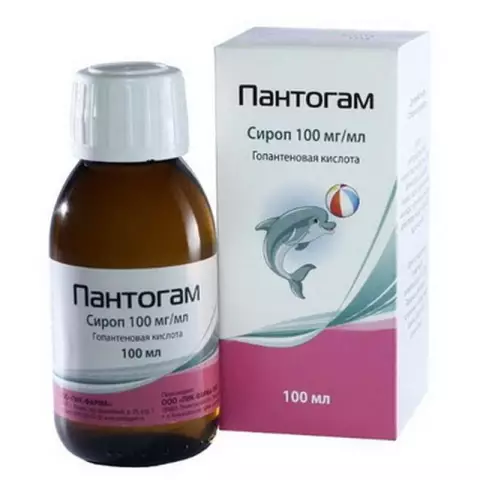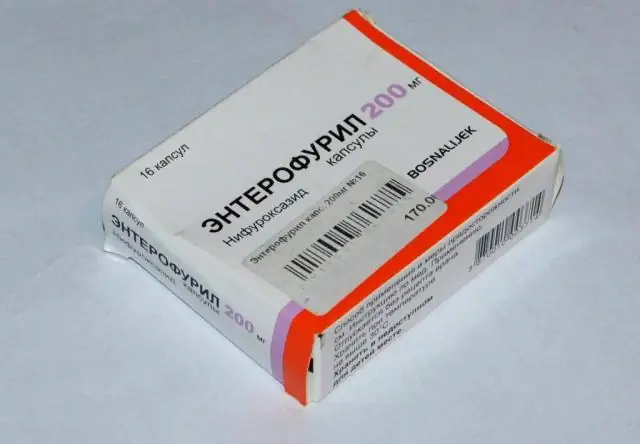- Author Rachel Wainwright [email protected].
- Public 2023-12-15 07:39.
- Last modified 2025-11-02 20:14.
Pantogam
Pantogam: instructions for use and reviews
- 1. Release form and composition
- 2. Pharmacological properties
- 3. Indications for use
- 4. Contraindications
- 5. Method of application and dosage
- 6. Side effects
- 7. Overdose
- 8. Special instructions
- 9. Application during pregnancy and lactation
- 10. Use in childhood
- 11. In case of impaired renal function
- 12. Drug interactions
- 13. Analogs
- 14. Terms and conditions of storage
- 15. Terms of dispensing from pharmacies
- 16. Reviews
- 17. Price in pharmacies
Latin name: Pantogam
ATX code: N06BX
Active ingredient: hopantenic acid
Manufacturer: LLC PIK-PHARMA PRO (Russia); PIK-PHARMA LEK LLC (Russia); LLC Firm VIP-MED (Russia)
Description and photo update: 2019-19-08
Prices in pharmacies: from 281 rubles.
Buy

Pantogam is a drug that has a nootropic and anticonvulsant effect.
Release form and composition
Dosage forms of Pantogam:
- Tablets: flat-cylindrical, white, with a line and a chamfer (10 pcs. In blisters, 5 packs in a cardboard box);
- Syrup: colorless or slightly yellowish in color, has a cherry smell (100 ml in dark glass bottles, 1 bottle in a cardboard box, a 5 ml measuring spoon is included).
The active substance is the calcium salt of hopantenic acid, its content:
- 1 tablet - 0.25 or 0.5 g;
- 5 ml of syrup - 0.5 g.
Excipients of tablets: methylcellulose, magnesium hydroxycarbonate, calcium stearate, talc.
Excipients of the syrup: sorbitol, sodium benzoate, glycerol, aspartame, citric acid monohydrate, purified water, food flavoring "Cherry 667".
Pharmacological properties
Pharmacodynamics
The spectrum of activity exhibited by Pantogam is due to the presence of gamma-aminobutyric acid (GABA) in its structure. The mechanism of action of the drug is associated with the ability of hopantenic acid to have a direct effect on the GABA (subtype B) receptor-channel complex.
The drug has an anticonvulsant and nootropic effect, increases the resistance of the brain to hypoxia and the negative effects of toxic substances. Pantogam stimulates the course of anabolic processes in neurons, reduces motor excitability, increases physical and mental performance, demonstrates a combination of a mild stimulating effect with a moderate sedative effect.
Pantogam normalizes GABA metabolism against the background of chronic alcohol intoxication and subsequent refusal to take ethanol. The drug lengthens the effect of novocaine (procaine) and sulfonamides as a result of the suppression of their acetylation reactions, which take part in the mechanism of inactivation of these drugs. Inhibits pathologically increased gallbladder reflex and detrusor tone.
Pharmacokinetics
The drug is rapidly absorbed from the digestive tract and passes through the blood-brain barrier. The highest concentrations are found in the kidneys, liver, stomach wall and skin. The drug does not undergo metabolic transformation and is excreted unchanged for 48 hours: with urine - 67.5% of the dose taken, with feces - 28.5%.
Indications for use
- Psycho-emotional overload, decreased physical / mental performance (the purpose of using Pantogam is to improve memory and concentration);
- Akinetic and hyperkinetic extrapyramidal syndrome due to the use of antipsychotics (treatment and prevention);
- Extrapyramidal disorders (including Huntington's chorea, Parkinson's disease, hepatolenticular degeneration, myoclonus epilepsy);
- Cognitive impairment due to neurotic disorders and organic brain damage (including the consequences of traumatic brain injury and neuroinfections);
- Neurosis-like states with tics, stuttering (predominantly clonic), inorganic encopresis and enuresis;
- Cerebrovascular insufficiency due to atherosclerotic changes in the vessels of the brain;
- Hyperkinetic disorders, including attention deficit hyperactivity disorder;
- Epilepsy with mental retardation (in combination with anticonvulsants);
- Schizophrenia, accompanied by organic cerebral insufficiency;
- Neurogenic urinary disorders (pollakiuria, enuresis, urgency, urinary incontinence);
- Violations of the psychological status in children, manifested by a general delay in mental development, specific disorders of motor functions, speech and their combination, the formation of school skills (writing, reading, counting, etc.);
- Mental retardation, including those with behavioral disorders;
- Various forms of cerebral palsy;
- Perinatal encephalopathy in children from the first days of life.
Contraindications
Absolute:
- Phenylketonuria (for syrup; due to aspartame content);
- Acute severe kidney disease;
- Pregnancy and breastfeeding;
- Hypersensitivity to any component of Pantogam.
Instructions for the use of Pantogam: method and dosage
Both dosage forms of Pantogam should be taken orally 15-30 minutes after a meal, given its nootropic effect - in the morning and afternoon (up to 17 hours).
In the form of tablets, the drug is prescribed for adults and children over 3 years old; it is advisable for young children to use syrup.
Average doses of Pantogam for adults are: single - 0.25-1 g, daily - 1.5-3 g; for children: single - 0.25-0.5 g, daily - 0.75-3 g.
The duration of treatment is from 1 to 4 months, in some cases - 6 months. If necessary, after a 3-6 month break, a second course of therapy is prescribed.
Recommended dosage regimens of Pantogam:
- Schizophrenia (as part of complex therapy with psychotropic drugs): 0.5-3 g per day for 1-3 months;
- Epilepsy (in combination with anticonvulsants): 0.75-1 g per day, treatment can last up to 1 year or more;
- Extrapyramidal neuroleptic syndrome (simultaneously with the main therapy): up to 3 g per day for several months;
- Extrapyramidal hyperkinesis in patients with hereditary diseases of the nervous system (simultaneously with the main therapy): 0.5-3 g per day, the duration of treatment is up to 4 months or more;
- Consequences of craniocerebral trauma and neuroinfections: 0.25 g 3-4 times a day;
- Asthenic conditions and increased loads (to restore working capacity): 0.25-0.5 g 3 times a day;
- Extrapyramidal syndrome due to the use of neuroleptics: adults - 0.5-1 g 3 times a day, children - 0.25-0.5 g 3-4 times a day, treatment is carried out within 1-3 months;
- Tics in children: 0.25-0.5 g 3-6 times a day for a course of 1 to 4 months;
- Urination disorders: adults - 0.5-1 g 2-3 times a day, children - 0.25-0.5 g per day (0.025-0.05 mg / kg) for 1-3 months;
- Pathologies of the nervous system in children: under 1 year old - 0.5-1 g per day, 1-3 years - 0.5-1.25 g per day, 3-7 years - 0.75-1.5 each g per day, over 7 years old - 1-2 g per day. Treatment always starts with a minimum dose and gradually, over 7-12 days, it is increased. At the maximum dose, Pantogam is used for 15-40 days, after which gradually, over 7-8 days, the dose is gradually reduced until the drug is completely discontinued. The general course of treatment lasts from 30 to 90 days, in some cases it can reach 6 months or more.
Side effects
- Allergic reactions: conjunctivitis, rhinitis, skin rashes (these reactions require a reduction in the dose of Pantogam or its complete cancellation);
- Others: drowsiness or sleep disturbances, noise in the head (these phenomena are usually short-term and do not require discontinuation of therapy).
Overdose
In case of an overdose of Pantogam, an increase in the severity of such adverse reactions as drowsiness or sleep disturbances, noise in the head is possible.
In this case, gastric lavage and intake of activated charcoal or other enterosorbents are recommended, if necessary, symptomatic treatment is carried out.
special instructions
With prolonged use of Pantogam, it is not recommended to simultaneously prescribe other nootropic drugs and drugs that stimulate the central nervous system.
The break between courses of therapy with Pantogam, like any other nootropic drug, should be 1-3 months.
Influence on the ability to drive vehicles and complex mechanisms
Due to the likelihood of drowsiness in the first days of therapy, care should be taken when driving and performing potentially dangerous types of work.
Application during pregnancy and lactation
According to the instructions, Pantogam is not recommended for use during pregnancy and breastfeeding, since there is no data confirming the effectiveness and safety of its intake during these periods.
Pediatric use
Pantogam tablets are contraindicated for children under 3 years of age. The syrup can be used from the first days of life according to the dosage regimen.
With impaired renal function
In the presence of acute severe kidney disease, taking the drug is contraindicated.
Drug interactions
It should be borne in mind that Pantogam:
- Prevents side effects of carbamazepine, phenobarbital, antipsychotics;
- Prolongs the action of barbiturates;
- Potentiates the action of local anesthetics (procaine);
- Enhances the effects of anticonvulsants.
Etidronic acid and glycine enhance the action of the calcium salt of hopantenic acid.
Analogs
The analogues of Pantogam are: Vinpocetine, Ginkgo Biloba, Glycine, Cavinton, Lucetam, Cortexin, Nootropil, Piracetam, Cerebrolysin, Thiocetam, Encephabol, Pantogam active, Pantocalcin, Gopantam, Calcium Rosantenat, Calcium-Hopantenat.
Terms and conditions of storage
Store in a dry (tablets), protected from light and out of reach of children at temperatures up to 25 ºС.
Shelf life:
- Tablets 0.25 g - 4 years;
- 0.5 g tablets - 3 years;
- Syrup - 2 years, after the first opening of the bottle - no more than 1 month if stored in the refrigerator.
Terms of dispensing from pharmacies
Dispensed by prescription.
Reviews about Pantogam
Reviews about Pantogam by doctors in most cases confirm the high effectiveness of this nootropic agent, especially in children with perinatal encephalopathy with hyperexcitability syndrome, hypodynamic syndrome, hyperactivity syndrome, delayed speech development, mild manifestations of enuresis, neurosis-like states. In adults, according to experts, the drug has shown good results in the combined treatment of anxiety disorders, panic attacks, and anxiety depression. Although the syrup is approved for use from the first days of life, some doctors advise using Pantogam in this dosage form for children over 3 months old. The disadvantages of the drug mainly include the development of skin allergic reactions.
Reviews of parents whose children took the drug are not so clear-cut. Many were satisfied with the action of Pantogam in the treatment of hyperexcitability (especially in children of the first year of life), increased tone, nocturnal enuresis, developmental delays, and epileptic seizures. In the reviews, they note that school-age children after a course of therapy have become more assiduous, learnable and attentive, they were able to endure overloads during the educational process much easier.
At the same time, according to other parents, there are no improvements in the condition of children after taking Pantogam, there are also complaints about the development of side effects in the form of sleep disturbances, mood swings, headaches, and allergic reactions. Sometimes doubts are expressed about the advisability of prescribing this serious drug by the attending physician to children with minor developmental disabilities; in such cases, it is recommended to consult with several specialists before starting treatment.
Adult patients mostly report a good therapy result.
Price for Pantogam in pharmacies
The average price for Pantogam is:
- tablets (per package containing 50 pcs.): in a dosage of 250 mg - 385-450 rubles; in a dosage of 500 mg - 640-700 rubles;
- syrup (per bottle of 100 ml): 380-460 rubles
Pantogam: prices in online pharmacies
|
Drug name Price Pharmacy |
|
Pantogam 100 mg / ml syrup 100 ml 1 pc. 281 r Buy |
|
Pantogam 250 mg tablets 50 pcs. 353 r Buy |
|
Pantogam tablets 250mg 50 pcs. 363 r Buy |
|
Pantogam syrup 10% 100ml 373 r Buy |
|
Pantogam active 300 mg capsules 60 pcs. 444 r Buy |
|
Reviews Pantogam asset 444 r Buy |
|
Pantogam active capsules 300mg 60 pcs. 526 r Buy |
|
Pantogam tablets 500mg 50 pcs. 607 r Buy |
|
Pantogam 500 mg tablets 50 pcs. 607 r Buy |
| See all offers from pharmacies |

Maria Kulkes Medical journalist About the author
Education: First Moscow State Medical University named after I. M. Sechenov, specialty "General Medicine".
Information about the drug is generalized, provided for informational purposes only and does not replace the official instructions. Self-medication is hazardous to health!






